Home > Digitized Walters Manuscripts
This document is a tranformation of a TEI P5 XML manuscript description incorporating images. If you have trouble reading special or non-Latin characters on this page, please make sure you have appropriate Unicode fonts installed and an up-to-date web browser.
Walters Ms. W.106, Bible pictures by William de Brailes
Browse images (Browse images in a new window) | TEI in XML format
W.106
Bible pictures by William de Brailes
Supplied name: W. de Brailes
Known as: William de Brailes
This manuscript comprises twenty-four leaves of Bible pictures by W. de Brailes, an English artist active in Oxford in the middle of the thirteenth century. Seven leaves from the same set of images are now in the Musée Marmottan in Paris. These thirty-one leaves are all that remain of an image cycle that once contained at least ninety-eight miniatures, and which was the longest cycle of Bible miniatures surviving from the thirteenth century in England. In all probability these Bible pictures were actually prefatory matter to a Psalter, now Stockholm, National Museum Ms. B.2010. De Brailes also composed and wrote the captions that accompany many of the images, a pattern of production observable in other manuscripts made by him, including London, British Library Ms. Add. 49999, a richly illuminated Book of Hours apparently intended for a female owner. W. de Brailes is one of only two English artists of the thirteenth century whose name we can associate with surviving works. Eleven manuscripts have been identified that contain miniatures in his hand. De Brailes has a quirky and chatty style and is extremely gifted at turning Bible stories into paint.
Ca. 1250 CE
Oxford, England
Supplied name: W. de Brailes
Known as: William de Brailes
Supplied name: W. de Brailes
Known as: William de Brailes
Book
The primary language in this manuscript is French, Old (842-ca.1400).
Parchment
Good quality parchment; leaves cut down and margins scraped clean
Foliation: vi+27+vi
Modern flyleaves; remains of seventeenth-century pagination on some folios, which can also be found on the Musée Marmottan folios; modern pencil foliation in the upper right corners (followed here); note that fol. 12 is now bound before fol. 11, which is bound before fol. 10
Catchwords: None
Signatures: None
Comments: No trace of original quire structure; leaves now all tipped in as singletons; correct order as follows: fols. 24, 1, 2, 3, 4, 14, 15, 16, 5, 6, 7, 9, 8, 11, 10, 13, 12, 19, 18, 17, 20, 21, 22, 23
9.5 cm wide by 13.2 cm high
7.5 cm wide by 10.0 cm high
- Columns: 1
- Ruled lines: 0
- Title: Bible pictures
- Text note: Text in the form of captions accompanying many of the illustrations
- Hand note: Written in small-format, semi-formal Gothic script
- Decoration note: Full-page miniatures on all folios; most folios blank on versos; fol. 11 blank on recto; fols. 17, 18, and 19 have miniatures on both recto and verso
fol. 1r:
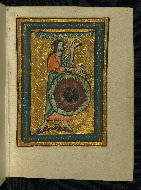
- Title: The first two days of Creation
- Form: Full-page miniature
- Text: Genesis 1:1-8
- Label: This folio depicts the Genesis story, condensing two days of Creation into one image. On the first day of Creation, God created heaven and earth, and the earth was without form and void. The Spirit of God moved across the face of the waters, and we see God himself gesturing with his right hand to the Spirit, shown in the form of a dove. God raises his left hand to the waters above him, which he separated from the firmament, beneath his feet, on the second day.
fol. 2r:
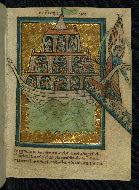
- Title: The animals enter Noah's ark
- Form: Full-page miniature
- Text: Genesis 6:13-7:16
- Label: This folio depicts a scene from the story of Noah's ark. God commanded Noah to build an ark of gopher wood, with a roof and three decks. Into the ark Noah brought two of every animal, male and female. On the lower deck we see the animals, on the middle deck, the birds, and on the upper deck, Noah and his family. The last birds are flying into the ark, and the last animals are being escorted by an angel. The flood has already started, and the ark, with its beast-headed prow and stern, floats upon its waters, pennant flying.
- Comment:
The inscription below the image reads, "God commanded that Noah make a three-leveled ark and that he put in it himself and his wife and their three sons, Cham, Sam, and Iafet, and their wives, and beasts and birds, two by two." (Above: ceo e[st] l[']arche noe; below: de cumanda noe fer un arche a tres astages e ke il me[ist] lens lui e sa fe[m]me e sa treis fiz. cham e sam e iafet e lur fe[m]mes e de bestes e de volatilie ii e ii.)
fol. 3r:
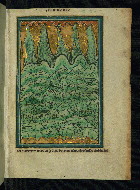
- Title: The flood of Noah
- Form: Full-page miniature
- Text: Genesis 7:11-24
- Label: This folio depicts a scene from the story of Noah's ark. Here, the ark is nowhere to be found. The fountains of the great deep have broken up, and the windows of heaven have been opened. Five great plumes of water tumble from a red heaven into a broiling ocean. It has already rained for many of the forty days, and the beasts, birds, and people of the earth are laid to rest in ordered strata, like sediment, on the ocean floor. The people are the last to drown. The great flood will prevail upon the earth for 150 days.
- Comment:
The inscription below the image reads, "Here all the people of the world and the beasts and the birds drown." (Above: le deluvie noe; below: ici neerent tute la gent del munde e bestes e volatilie.)
fol. 4r:
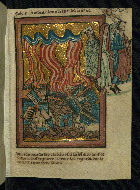
- Title: Lot and his family flee Sodom
- Form: Full-page miniature
- Text: Genesis 19:15-26
- Label: This folio depicts a scene from the story of Sodom and Gomorrah. Having saved Lot and his family from the Sodomites, the angels instructed him to flee the city with his wife and two daughters because the angels were about to destroy it. Lot lingered, so they took his hand, and those of his family, and placed them outside the city, and instructed them to flee to the small city of Zoar, without looking back. However, Lot's wife disobeyed, and upon looking back she was turned into a pillar of salt. The artist deftly utilized the whole page to more vividly convey the escape of Lot and his daughters from the destroyed city. The three figures flee the framed miniature for the safety of the bare parchment of the right margin, where they tread on a cool patch of green grass.
- Comment:
The inscription below the image reads, "God commanded Lot and his wife and his daughters to go out of Sodom without looking [back]. Lot's wife looked [back]. God changed her into a salty rock." (Above: Sodom. foudre. lot e sa du fiiles. sa fe[m]me.; below: deu comaunda lot e sa fe[m]m e sas fiiles aler hors de sodom, sens regarder. la feme lot regarda. deu la mua en une pere saline.)
fol. 5r:
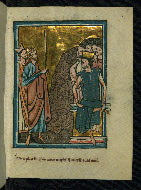
- Title: The third plague of Egypt: gnats
- Form: Full-page miniature
- Text: Exodus 8:17
- Label: This folio depicts a scene from Exodus, in which God rained plagues upon Egypt. After plagues of blood and frogs, Pharaoh hardened his heart again and would not let the Israelites leave Egypt. God told Moses to tell Aaron to stretch forth his rod and strike the dust of the earth that it may become gnats throughout the land of Egypt. Here, Moses (shown horned as a sign of his encounter with divinity) carries the rod, while Aaron, wearing the miter of a priest, stands behind him. The gnats arise en masse out of the dust from which they were made and attack Pharaoh, seated and crowned, and his retinue.
- Comment:
The inscription reads, "The third plague was that he made gnats fly to their necks." (In terce plaie fu q[u'i]l fit venir cinifes q[ui] volerent en les cous.)
fol. 6r:
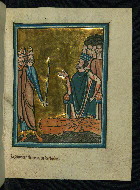
- Title: The fifth plague of Egypt: cattle
- Form: Full-page miniature
- Text: Exodus 9:1-6
- Label: This folio depicts a scene from Exodus, in which God rained plagues upon Egypt. In the fifth plague, one of the most severe, all of the Egyptians' cattle died. Here Moses (shown horned as a sign of his encounter with divinity) repeats his plea to Pharaoh to let the Israelites go, but still he refuses.
- Comment:
The inscription reads, "The fifth was the death of the animals." (la quinte fu murine de bestes.)
fol. 7r:
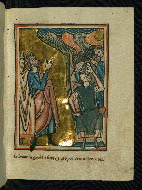
- Title: The seventh plague of Egypt: hail
- Form: Full-page miniature
- Text: Exodus 9:22-26
- Label: This folio depicts a scene from Exodus, in which God rained plagues upon Egypt. Moses (shown horned as a sign of his encounter with divinity) stretched out his hand, and there came forth hail throughout the land of Egypt. Thunder, hail, and fire rained down from heaven. Yet still the Pharaoh refused to let the Israelites leave Egypt.
- Comment:
The inscription reads, "The seventh was hail and fire throughout Egypt and lasted eight days." (la setime fu gresil e fudre p[ar] egypte e dura viii iorz.)
fol. 8r:
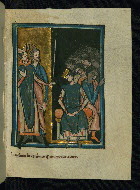
- Title: The ninth plague of Egypt: darkness
- Form: Full-page miniature
- Text: Exodus 10:22-23
- Label: This folio depicts a scene from Exodus, in which God rained plagues upon Egypt. The Lord told Moses (shown horned as a sign of his encounter with divinity) to stretch forth his hand that a darkness might be placed over Egypt, a darkness that could be felt. Moses did so, and a darkness fell over the land for three days, but all the people of Israel had light where they dwelt. Yet still the Pharaoh would not let the Israelites leave Egypt.
- Comment:
The inscription reads, "The ninth plague was darkness, so that no one could see another." (le nefime fu tenbrur q[ue] nul ne vit autre.)
fol. 9r:
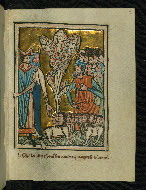
- Title: The eighth plague of Egypt: locusts
- Form: Full-page miniature
- Text: Exodus 10:12-15
- Label: This folio depicts a scene from Exodus, in which God rained plagues upon Egypt. The Lord told Moses to stretch forth his hand that locusts might come and eat every plant in the land, all that the hail had left. A dense swarm of locusts settled over all the land, one so dense that its like had never been seen before, nor would be seen again.
- Comment:
The inscription reads, "The eighth innumerable locusts and wingless locusts, which ate the trees." (la .viii,eme locusta & bruc[us] sen numbre q[ui] mangere[n]t les arbres.)
fol. 12r:
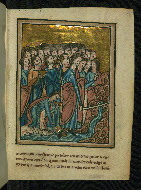
- Title: Moses strikes water from the rock
- Form: Full-page miniature
- Text: Numbers 20:10-11
- Label: This folio depicts a moment during the wandering of the Israelites in the desert after their escape from the bondage of Egypt. The Israelites came into the wilderness of Zin, an evil place, and thought that they would die there, because there was no water. Moses (shown horned as a sign of his encounter with divinity) struck a rock with his staff, and water flowed from it.
- Comment:
The inscription reads. "When Moses led the people through the desert, they did not find any water. Then the people murmured and said that they wished more to have remained in servitude in Egypt than to die here of thirst. Moses struck the rock; water issued from it. They drank." (Quant myses amen[a] le peple p[ar] le desert ne truverent puint de ewe dunc grucea le peple [e] dit q[ue] meuz voleint aver alte en servage en egypte q[ue] la murir de seif. moises feri en la roche. ewe en issi il bure[n]t.)
fol. 11v:
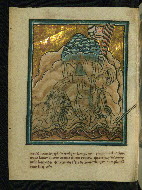
- Title: The crossing of the Red Sea
- Form: Full-page miniature (part of a double opening along with the facing page, fol. 10r)
- Text: Exodus 14:26-30
- Label: This folio depicts a scene from Exodus, in which the Israelites escape their bondage in Egypt. After God sent many plagues, the Pharaoh at last agreed to let the Israelites leave, but then changed his mind and pursued them. The Israelites crossed over the Red Sea, after God had made all the sea dry land. In this image, God allows the waters to return, drowning Pharaoh's army.
- Comment:
The inscription reads, "Moses led the people of Israel through the Red Sea. Pharaoh pursued them, found the sea open, found the path, and entered. When Moses had brought his people across, he returned there and struck the sea. It closed and drowned the Pharaoh and all his host." (Moises amena le peple de irael p[ar]mi la ruge mer. pharaon les pursiwi, truva la mer overte e truva chemi e entre. quant moyses aveit passe sun people i se returna e feri en la mere ele clot & nea pharao[n] e tut sun ost.)
fol. 10r:
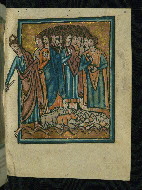
- Title: The crossing of the Red Sea
- Form: Full-page miniature (part of a double opening along with the facing page, fol. 11v)
- Text: Exodus 14:26-30
- Label: This folio depicts a scene from Exodus, in which the Israelites escape their bondage in Egypt. After God sent many plagues, the Pharaoh at last agreed to let the Israelites leave, but then changed his mind and pursued them. The Israelites crossed over the Red Sea, after God had made all the sea dry land. In this image, Moses uses God's power to allow the waters to return, drowning Pharaoh's army.
- Comment:
The inscription reads, "Moses led the people of Israel through the Red Sea. Pharaoh pursued them, found the sea open, found the path, and entered. When Moses had brought his people across, he returned there and struck the sea. It closed and drowned the Pharaoh and all his host." (Moises amena le peple de irael p[ar]mi la ruge mer. pharaon les pursiwi, truva la mer overte e truva chemi e entre. quant moyses aveit passe sun people i se returna e feri en la mere ele clot & nea pharao[n] e tut sun ost.)
fol. 13r:
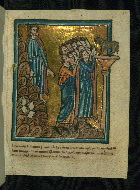
- Title: The Israelites worship the golden calf and Moses breaks the tablets
- Form: Full-page miniature
- Text: Exodus 32:1-19
- Label: This folio depicts a moment when the Israelites were in the desert after their escape from Egypt. Moses (shown horned as a sign of his encounter with divinity) had been on Mount Sinai, alone, receiving instructions from God. The Israelites strayed from faith in God in his absence.
- Comment:
The inscription reads, "When Moses went to the mountain to receive the Law, God said to him, 'Go down. Your people sin.' Moses descended and saw his people adoring a calf, which they made of gold and silver. When he saw this, he grew angry at them [and] hurled his tablets against the rock so that they broke." (Cum moyses fu al munt p[our] receivre la lei de[u] lu dit dece[n]de tun peple pecche. moysen d[e]se[n]d li vit sun peple aurer un veel q[u'i]l aveint fet d[']or e d[']argent. q[ua]nt ceo vit, li se corra, rua sa tables encuntre la roche q[u'i]l debruser[en]t.)
fol. 14r:
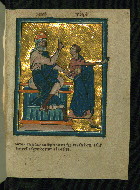
- Title: Jacob sends Joseph to his brothers
- Form: Full-page miniature
- Text: Genesis 37:13-14
- Label: This folio depicts a scene from the story of Joseph. Joseph was the youngest of Jacob's twelve sons, a dreamer, beloved by his father and hated by his brethren. One day, Jacob, seated on a grand chair as befits a patriarch, said to Joseph, "Go now, see if it is well with your brothers and with the flock and bring me word again."
- Comment:
The inscription below the image reads, "Jacob sends Joseph, his son, to Sichen to his brothers who were guarding the beasts." (Above: iacob ioseph; below: iacob enveat ioseph suen fiz en sichen a sas freres q[ui] gardient les bestes.)
fol. 15r:
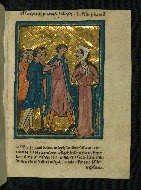
- Title: Pharaoh's wife accuses Joseph
- Form: Full-page miniature
- Text: Genesis 39:7-20
- Label: This folio depicts a scene from the story of Joseph. Joseph's brothers betrayed him and sold him to a group of Ishmaelites, who then sold him in Egypt. Joseph rose fast, becoming Pharaoh's most trusted adviser. Joseph, handsome and successful, refused the advances of Pharaoh's wife, who grabbed Joseph by his cloak as he ran away from her and then accused him of attempting to rape her. Joseph was then thrown into prison.
- Comment:
The inscription below the image reads, "The wife of Pharaoh desires that Joseph be her lover and commanded him into her chamber. Joseph said that this does not frighten him because he believed in God and she not at all and she did not fear treason to their Lord. She cried out [and] said that Joseph stole her by force. He was imprisoned." (Above: les sergeanz pharao[n]. ioseph. la fe[m]m pharao[n]; below: la fe[m]me pharao[n] desira ioseph de estre seo[n] ami e le mandi en sa chambre. ioseph dist q[ue] ceo ne freit ker il cruet en deu e ele neant e ne freit t[re]isu[n] a sun seinur. ele cria dist q[ue] ioseph la vole a forcer. le[n] le enp[ri]suna.)
Like WAM Ms W.106, fol. 15r, some late medieval works depart from the scriptural account in showing the wife of Pharaoh, rather than Potiphar’s wife, attempting to seduce and then falsely accusing Joseph. This apocryphal detail, attested in contemporary biblical paraphrases, also occurs in the sculptural program of ca. 1265 in the chapter house of Salisbury Cathedral, and in the Old Testament prefatory cycle in the early fourteenth-century Queen Mary Psalter (London, British Library MS Royal 2. B. VII, fol. 16r).
fol. 16r:
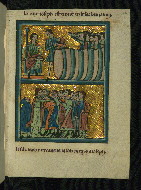
- Title: Joseph's cup found in Benjamin's sack; the reunion of Jacob and Joseph
- Form: Half-page miniatures
- Text: Genesis 44:12; Genesis 46:29
- Label: This folio depicts two scenes from the life of Joseph. Above, Joseph rose from disaster to rule Egypt under Pharaoh. His brothers came seeking grain. Joseph had their sacks filled, but had a cup placed in the sack of Benjamin, the youngest of the brothers. Below, the brothers brought Jacob to Joseph, who went to meet him in Goshen. Joseph fell on his father's neck and wept. The elderly Jacob said to Joseph, "Now let me die, since I have seen your face and know that you are still alive."
- Comment:
The inscription for the above image reads, "Joseph's cup is found in Benjamin's bag." (la cupe ioseph est trove en le sac beniamin.) The inscription for the below image reads, "The sons of Jacob brought Jacob to Joseph in Egypt." (le filz iacob unt amene iacob en egypte a ioseph.)
fol. 17r:
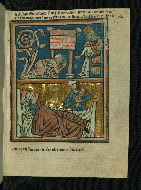
- Title: Hannah prays in the temple; Hannah gives birth to Samuel
- Form: Half-page miniatures
- Text: 1 Samuel 1:9-17; 1 Samuel 1:20
- Label: This folio depicts two scenes from the life of Samuel. Above, Hannah, the barren wife of Elkanah, went to the temple where the Ark of the Covenant was, and prayed to the Lord and wept bitterly. She vowed that if God gave her a son then she would give him to God. Eli the priest saw her praying and thought that she was drunk. Below, in due time, Hannah conceived and bore a son, and she called him Samuel. Samuel was to crown David, King of Israel.
- Comment:
The inscription above the top image has been partially cut off, but the remainder reads: "... Eli said that she was drunk. Hannah said, 'No, I drank neither wine nor beer but I asked God for a child.' 'God will give him,' said Eli." (... heli dit q[u'e]le asteit yure. n[on] dit anna je ne beu nukes vin ne serveise meis ieo req[ue]r a deu enfaunt deu leu[s] dunist dit heli.) The inscription below the image reads, "Hannah gave birth to a son and he was named Samuel." (anna enfaunta un fiz e fu nume samuel.)
fol. 17v:
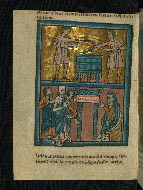
- Title: Eli's sons commit sacrilege; Hannah brings Samuel to the temple
- Form: Half-page miniatures
- Text: 1 Samuel 2:13-17; 1 Samuel 1:24
- Label: This folio depicts two scenes from the life of Samuel. Above, the priest Eli's sons Hophni and Phinehas were also priests at the temple, and they took sacrifices that had been made at the temple before the fat had been burned; they wanted it raw. The sin that they committed was very great in the eyes of God. Below, when Samuel was weaned, Hannah and Elkanah brought him to the temple.
- Comment:
The inscription for the above image has been partially cut off, but the remainder reads, "... with all the blood and they stole it. God grew angry because Eli consented to it." (... od tut le sanc e l[']emblerent. deu se curuza q[ua]r heli i cunsenti.) The inscription below the image reads, "Elkanah and Hannah brought Samuel to the temple and offered him to God. He remained there with Eli, guarding the Ark." (helcana e anna porterent samuel al temple e l[']offurent a deu la remist od heli gardau[n]t l[']arche.)
fol. 18r:
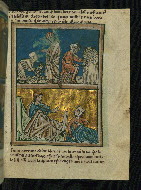
- Title: Ruth meets Boaz as she gleans; Boaz sees Ruth at his feet
- Form: Half-page miniatures
- Text: Ruth 2:4-16; Ruth 3:6-14
- Label: This folio depicts two scenes from the life of Ruth. Naomi and her daughter-in-law Ruth were destitute. Ruth went to glean barley, following the reapers in the fields of Boaz, who was a kinsman of Naomi's late husband. After Boaz shows Ruth kindness by allowing her to have some of the barley, Ruth sleeps at Boaz's feet and is taken to bed with him.
- Comment:
The inscription above the image reads, "Ruth went to glean in Boaz's field. Boaz said to his reapers that they should leave the ears of the wheat so that Ruth would have no shame. Boaz asked her who she was and she said that she was a foreigner." (ruth ala grever al camp booz. booz dit a sas mescinins q[u'i]l lesessent cheir del ble q[ue] ruth n[']ust hunte. booz lui damaundi q[ui] ele asteit el dit q[ue] le asteit aliana.) The inscription below the image reads, "She went to Naomi with her wheat. Naomi looked at her and said to her that she should join with Boaz's young women and that she should sleep at Boaz's feet. Ruth did so. Boaz noticed her and took her to bed but he did not know her." (e[le] vint a noemie od sun ble. noemie la revea [e] lu dit q[u'e]le se ioinst as anceles booz e q[ue] ele se cuchast as pez booz. ruth le fist issi. booz la ap[er]ceut e prist cugir mei il ne la cunut.)
fol. 18v:
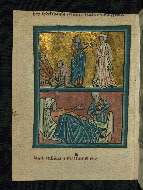
- Title: Boaz's kinsman renounces his rights over Ruth; Ruth gives birth to Obed
- Form: Half-page miniatures
- Text: Ruth 4:2-10; Ruth 4:13-17
- Label: This folio depicts two scenes from the life of Ruth. Above, Boaz wanted to marry Ruth, but her mother-in-law Naomi had a kinsman who had a better right to her. Boaz persuaded the kinsman to give up his rights to Ruth and, in token of the fact, the kinsman took off his sandal and gave it to Boaz. Below, Ruth bore a son, and Naomi took him and laid him on her bosom and became his nurse. They named him Obed; he was the father of Jesse, who was the father of David, the ancestor of Christ.
- Comment:
The inscription above the image reads, "Boaz took off his shoe and knew Ruth and she became pregnant." (boz se deschausa e cunut ruth e ele fu grose.) The inscription below the image reads, "Ruth gave birth to a son and he was named Obed." (Ruth enfau[n]ta un fiz e fu nume obed.)
fol. 19r:
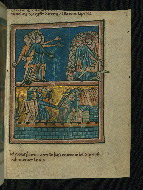
- Title: The stoning of Achan; the capture of Ai
- Form: Half-page miniatures
- Text: Joshua 7:25; Joshua 8:19-28
- Label: This folio depicts two scenes from the life of Joshua. Above, a man named Achan had stolen some things from Jericho that had been promised to God. Because of this the people of Israel fled before the men of Ai. Achan confessed his crime to Joshua; he had stolen silver and gold. The Israelites took Achan and his family and stoned them. Below, under the command of Joshua, the Israelites captured the city of Ai.
- Comment:
The inscription above the image has been partially cut off, but the remainder reads, "... gold and silver and bronze. They were stoned to death." (... mens d[']or de arge[n]t [e] d[']areim. il furent lapidez.) The inscription below the image reads, "The Hebrews took the city of Ai and killed the citizens and burned the city." (les ebreus p[ri]strent la cite de hay, e tuerent les citezeins e alumerent la vile.)
fol. 19v:
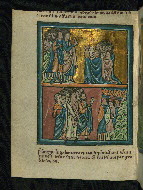
- Title: The Gibeonites make peace; the enemies of Gibeon slain
- Form: Half-page miniatures
- Text: Joshua 8:19-28; Joshua 10:6-12
- Label: This folio depicts two scenes from the life of Joshua. Above, when the inhabitants of Gibeon heard what the Israelites had done to Ai, they decided to make peace with them. They pretended to be from far away and dressed up in worn-out clothes, carried old provisions, and told the Israelites that they were their servants. Joshua made peace with them. Below, the kings of the Amorites made war against Gibeon. The Gibeonites beseeched Joshua to help them.
- Comment:
The inscription above the image has been partially cut off, but the remainder reads, "... came to the Hebrews on account of the marvels that they had heard speak of, if they offered bread and wine to them." (... vindrent as hebrus p[our] le marvailes q[ue] aveint oi dire si lur offrirent pain e vin.) The inscription below the image reads, "Then the Gibeonites were invaded by several kings of the mountains. They were rescued by Joshua, because God killed them with hail from the sky. (p[uis] furent le gaboenite envai de plusu[r]s reis de[s] mutaine[s] p[ar] iosue sunt delivre, q[ua]r deu les tua par gresile du cel.)
fol. 20r:
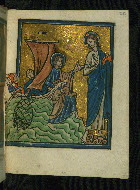
- Title: Christ appears at Lake Tiberias
- Form: Full-page miniature
- Text: John 21:1-9
- Label: This folio depicts a scene from the life of Christ. After the Resurrection of Christ, Simon Peter went fishing on Lake Tiberias with several other disciples, including John. They caught nothing that night, but just as day was breaking Christ stood on the beach. They did not recognize him at first. He told them to cast their net on the right side of the boat. Suddenly, they could not haul in the net for all the fish they had caught. John then said to Simon Peter, "It is the Lord." Simon Peter put on his clothes and sprang into the sea. The other disciples went to shore in the boat because it was not far from land.
fol. 21v:
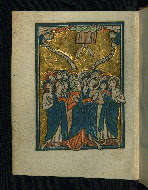
- Title: The Ascension
- Form: Full-page miniature
- Text: Acts 1:9-11)
- Label: This folio depicts a scene from the life of Christ. After his Resurrection, Christ appeared to the Apostles and his mother one final time. After he told them that the Holy Spirit would come upon them, he was lifted up, and a cloud took him out of their sight. While they were gazing into heaven, two men appeared and said, "Men of Galilee, why do you stand looking into heaven? This Jesus, who was taken up from you into heaven, will come in the same way as you saw him go into heaven."
- Comment:
The inscription in the image reads, "Men of Galilee, why do you look?" (VIRI GALILEI Q[U]ID ASPICITIS).
The ascending Jesus vanishing into the cloud is shown as the “disappearing Christ” - only his legs and feet are visible to the Apostles below. This manner of representing the Ascension, which originated in Anglo-Saxon art, conveys the idea that Christ’s disappearance from the Apostles’ view was necessary so that they could see him as God as well as man - as both divine and human.
fol. 22v:
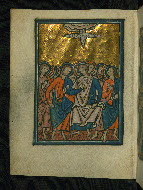
- Title: Pentecost
- Form: Full-page miniature
- Text: Acts 2:1-4
- Label: This folio depicts a scene from the life of Christ. After Christ ascended into heaven, the day of Pentecost came. All the Apostles were sitting in one place, and a sound came from heaven like the rush of a mighty wind. They were all filled with the Holy Spirit and began to speak in other tongues.
fol. 23r:
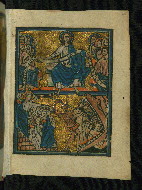
- Title: The Last Judgment
- Form: Full-page miniature
- Text: Matthew 25:31-46
- Label: This folio depicts the Last Judgment. Christ had said that when the Son of Man comes in his glory, he will sit on his glorious throne. Before him, all the nations will be gathered, and he will separate them one from another, the sheep on his right, the goats on his left. To the ones on his right he will say, "Come, O blessed of my Father, inherit the kingdom prepared for you from the foundation of the world." Then he will say to those on his left, "Depart from me, you cursed, into the eternal fire prepared for the devil and his angels." The Apostles accompany the Son of Man in heaven, while below, St. Michael welcomes the blessed to his right, and, on his left, the devil pitchforks the cursed into the monstrous hellmouth last seen on the first folio of the book, prepared for the rebel angels.
- Comment:
The inscription in the image reads, "Welcome, O blessed. Descend, O cursed." (VENITE BEN[EDICTI] [DESCEND]ITE MALEDICTI).
A more elaborate Last Judgment, which includes a vignette showing St. Michael rescuing a tonsured William de Brailes among the Damned, is the subject of one of six leaves illuminated ca. 1240 by de Brailes that once probably formed part of the prefatory cycle of a small psalter (Cambridge, Fitzwilliam Museum MS 330, leaf 3).
fol. 24r:
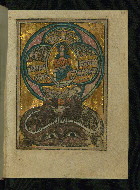
- Title: The Fall of the rebel angels
- Form: Full-page miniature
- Text: Apocryphal
- Label: This folio depicts the Fall of the rebel angels. In the center of heaven, God, cross-nimbed with his hands in his lap, sits on a throne within a mandorla. Ranks of angels surround him in circular compartments, looking this way and that. The lowest rank of angels, to the left and right of God, is empty. The rebel angels are seen in the compartment below, falling headlong out of heaven and into a brown hellmouth. The jaws of the beast-headed hellmouth, with their crenellated teeth, engulf the fallen angels. As they fall, the angels become demons. Their flesh turns from white to dark brown, and their human faces become bestial, with long ears, great bulging eyes, and large grimacing jaws. Their orange wings have disappeared, to be replaced in one case by a blazing orange loincloth. Evil has been established.
- Comment:
The theme of the Fall of the Rebel Angels was popular in English Bible illustration. In his depiction of this subject on Cambridge, Fitzwilliam Museum MS 330, leaf 1, one of six leaves that once probably formed part of the prefatory cycle of a small psalter, de Brailes also included personifications of three Virtues and three Vices, details that enhance the image’s moralizing message.
The binding is not original.
Early twentieth-century binding by Leon Gruel, Paris; shaped millboard, covered in worn red velvet incorporating a double-sided, fourteenth-century Rhenish ivory on the upper board; upper board outside depicts the Nativity; upper board inside depicts the Crucifixion
Edith Corf, Prioress of Tarent Kaines, Dorset, fourteenth century
Stockholm, National Museum Ms. B.2010 (inscription on fol. 1r)
Léon Gruel, Paris, by purchase, late nineteenth or early twentieth century
Henry Walters, Baltimore, purchased from Gruel in 1906 (invoice, Walters Art Museum archives, filed under Gruel)
The Walters Art Museum, by Henry Walters bequest, 1931
Randall, Richard H. Masterpieces of Ivory from the Walters Art Gallery. New York: Hudson Hills Press in association with the Walters Art Gallery, 1985, p. 220, no. 314.
Randall, Lilian M. C. "En Route to Salvation with William de Brailes." In Medieval Codicology, Iconography, Literature, and Translation: Studies for Keith Val Sinclair. Peter Rolfe Monks and D. D. R. Owen, eds. Leiden, The Netherlands and New York: E. J. Brill, 1994, pp. 83-93.
Cockerell, Sydney C. The Work of W. de Brailes, an English Illuminator of the Thirteenth Century. Cambridge: Roxburghe Club, 1930.
Morgan, Nigel. “Old Testament Illustration in Thirteenth-Century England.” In The Bible in the Middle Ages: Its Influence on Literature and Art. Bernard S. Levy, ed. Medieval and Renaissance Texts and Studies, LXXXIX (1992), 149-98.
Millar, E. "Additional Miniatures by W. de Brailes." Journal of the Walters Art Gallery 2 (1939): 106-109.
Noel, William. The Oxford Bible Pictures. Luzern, Switzerland: Faksimile Verlag in association with the Walters Art Museum, 2004.
Noel, William. “William de Brailes in Baltimore, Paris, and Stockholm." In Tributes in Honor of James Marrow: Studies in Painting and Manuscript Illumination of the Late Middle Ages and Northern Renaissance. Jeffrey F. Hamburger and A. S. Korteweg, eds. London: Harvey Miller, 2006, pp. 353-359.
Swarzenski, H. "Unknown Bible Pictures by W. de Brailes and Some Notes on Early English Bible Illustration." Journal of the Walters Art Gallery 1 (1938): 55-69.
Morgan, N. J. Early Gothic Manuscripts. Vol. 1, 1190-1250. A Survey of Manuscripts Illuminated in the British Isles 5. London: Harvey Miller, 1982, no. 71.
Principal catalogers: Herbert, Lynley; Noel, William; Smith, Kathryn
Cataloger: Walters Art Museum curatorial staff and researchers since 1934
Editors: Herbert, Lynley; Noel, William
Copy editor: Bockrath, Diane
Conservators: Owen, Linda; Quandt, Abigail
Contributors: Bockrath, Diane; Dutschke, Consuelo; Emery, Doug; Grollemond, Larisa; Herbert, Lynley; Noel, William; Pizzinato, Riccardo; Tabritha, Ariel; Toth, Michael B.
The Walters Art Museum
Licensed for use under Creative Commons Attribution-NonCommercial-ShareAlike 3.0 Unported Access Rights, http://creativecommons.org/licenses/by-nc-sa/3.0/legalcode. It is requested that copies of any published articles based on the information in this data set be sent to the curator of manuscripts, The Walters Art Museum, 600 North Charles Street, Baltimore MD 21201.